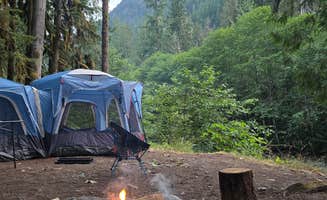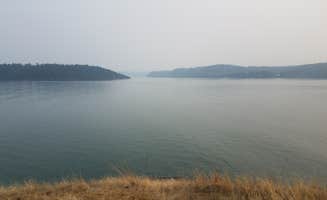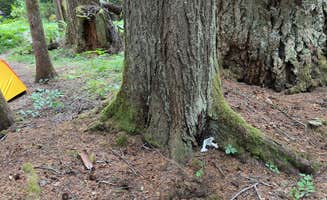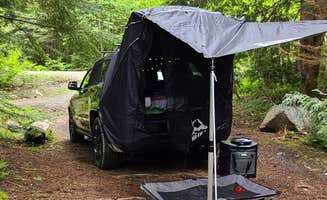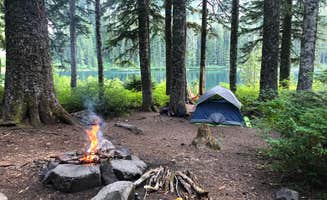Dispersed camping opportunities near Everett, Washington can be found within a 45 to 90-minute drive in national forest lands. The Mount Baker-Snoqualmie National Forest contains hundreds of primitive campsites across elevations ranging from 500 to 3,000 feet. Seasonal access varies, with most areas accessible from May through October, while winter snow can make many forest service roads impassable from November through April.
What to do
Hiking from camp: Several dispersed sites provide direct access to trail systems. The Lake Dorothy area offers "a really great area with a reasonable hike-in. The lake is ice cold, which is nice if you're just finished a hot hike in. There are some areas sort of cleared for camping, that have clearly been used before," according to one backpacker at Lake Dorothy.
Riverside relaxation: Free camping near Everett gives access to numerous creek and river spots. At Old Cascades Highway Dispersed, one camper noted, "We could walk to the river and sit by it for the evening before heading back to the car to sleep. We'll probably be back here!"
Berry picking: When in season, the Skykomish area offers "Fantastic berry picking & great views (when there is no smoke)," as reported by a visitor to the Highway 2 corridor.
What campers like
Natural noise buffers: The sound of moving water helps mask road and rail noise at many sites. A camper at Suiattle Riverside Camp described their spot as "so beautiful over looking a stream rushing over rocks. Ferns and big pines in the background."
Wooded seclusion: Many free camping areas near Everett feature dense forest coverage. One camper found spots along Mountain Loop Highway with "Meandering sites along the river with good logs for benches and fire rings made from forest rocks. Heavily forested and beautiful."
Cell service availability: Unlike many wilderness areas, several dispersed camping spots maintain connectivity. At South Fork Snoqualmie River Dispersed Site, a reviewer mentioned, "We have Verizon and have decent service, even with crappy weather."
What you should know
Road conditions vary widely: Access to many sites requires driving on unpaved roads with varying maintenance levels. A visitor to Mountain Loop Hway Dispersed Camp warned, "The directions had me believing that the dispersed camping was just various pull offs on the highway loop and that's where I stayed. It was loud and it felt like the traffic was coming through my tent at times... Once the highway turned into a gravel road is when I started seeing nice dispersed campsites."
Early arrival recommended: Popular spots fill quickly on weekends from June through September. "There are a ton of really great sites along this road, although most of the drive-in sites will be taken if it's a busy weekend, so get there early!"
Waste management issues: Many free camping locations suffer from improper waste disposal. One frustrated camper reported, "I had to clean up a lot of trash when I got here. Please pack out your own trash and follow other leave no trace rules."
Tips for camping with families
Hazardous plant awareness: Some sites have dangerous vegetation. A camper at South Fork Snoqualmie River noted, "Lovely area such beautiful surroundings. But be very cautious as near one of the camp sites are very dangerous plants that are fatal and they are lined all around the campground so not recommended if you have children."
Bug protection essential: Insect activity varies by season and location. One camper suggested, "Bring some bug spray! Seeing as there is water nearby, there are plenty of mosquitoes."
Safety considerations: Solo campers should exercise additional caution. One camper at Dispersed Camping Beckler Creek shared a positive experience: "Nice large campsite near the water. There were many campsites along the road."
Tips from RVers
Ground clearance requirements: Many forest service roads have rough sections that challenge vehicles. A reviewer cautioned, "Access road is right off the highway and unpaved, has a TON of holes so I wouldn't recommend driving down it without good ground clearance."
Size limitations: Most dispersed areas accommodate smaller RVs better than large ones. "It was hard to find a large enough spot that was also level to park our van," explained one camper who stayed along Old Cascades Highway.
Site selection strategy: For RV camping at free sites near Everett, continuing down access roads often yields better results. "If you keep going down the road you'll find plenty of quiet and private places," advised one RV camper.


